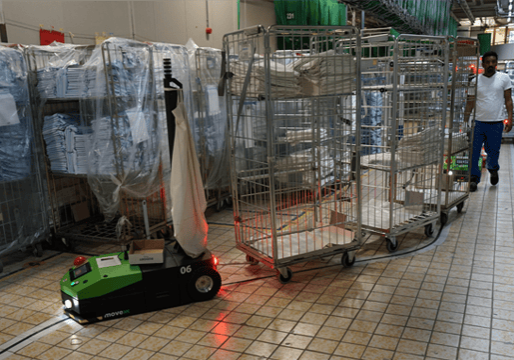A common concern with automation is that robots will replace people. The reality, at least at Rentex, a commercial laundry in Holland that Textile Services Weekly recently visited, is that robots make peoples’ jobs safer, easier and more efficient. Read on to learn more about Rentex and watch for an upcoming article in Textile Services magazine.
Rentex is a large, multi-level family-owned healthcare laundry in Bolsward, the Netherlands. This third-generation company moved into robotics, big time, about a year ago. Today, this large, multilevel laundry uses two types of robots. The first are called automated guided vehicles (AGVs). Also known as “smart electric tugs.” These small robots pull carts along on a track in the floor. They stop to let employees load textiles as the AGVs move around the finishing area. Rentex’s second robotics innovation is a robotic arm that automatically lifts racks of garments and places them on a cart. Sheathed in safety fencing, it’s difficult to see the system in action. Click here for a clearer view.
Rentex developed these systems with four companies. They include ABS Laundry Business Solutions, which handles the route-accounting work and develops manifests that guide employees in loading the carts pulled by the AGVs. A second partner is JENSEN, which handles the garment sortation via a Metricon rail system. The two other partners are Dutch robotics companies, Movexx and DBM industrial.
Jelco van der Duim, the production manager for Rentex, says the automation systems came about through discussions among company leaders and the vendors. Sometimes having nonlaundry specialists involved in talks is helpful he said. “Laundry machinery suppliers don’t always innovate at the pace we would like to see,” van der Duim said in “Rentex: Lending a Robotic Hand to Laundering,” the article planned for an upcoming issue of Textile Services. “We therefore look at other industries and their application of a process, to learn from them and see if certain automation possibilities are applicable in the laundry industry. Of course, we also work with our regular suppliers to jointly improve our processes. That’s how the idea of the clothing robot came about.”
After a full year’s operation, van der Duim and his colleague, Wiljan van den Hoven, team leader for the company’s technical department, are pleased with their move to automation. It builds on the plant’s existing equipment, including seven Lavatec tunnel washers and three ironer lines, including two from JENSEN and a third from Lavatec. Most of the feeders and folding equipment are also from JENSEN. The plant occupies 226,000 square feet (21,000 square meters). Rentex processes roughly 1.1 million lbs. (498,000 kg.) per week.
Key benefits of the move to automation by Rentex include:
Enhanced Safety and Productivity: van der Duim says the automated equipment has expanded throughput. But he emphasized that a bigger benefit is fewer injuries from pushing carts and bending and lifting to move textiles during the production process. “It ends up saving us almost two people a day,” says van der Duim of the new system. “But that was not the only consideration for entering into this project with our suppliers. Especially ergonomically, this is a great advantage for our employees. No more repetitive actions with hanging the clothes in roll containers. By using AGVs (automated guided vehicles) made by Movexx, which pull a train of four roll containers, we make the work a lot more pleasant and efficient.”
Manageable Maintenance: U.S. launderers often express concerns about advanced technology because they lack the in-house expertise necessary to keep these systems running. In Rentex’s case, van der Duim says his 13-member maintenance team can handle most problems in-house. “The maintenance of the robot is low. Our own technical department is trained to solve common disruptions themselves. In addition, it is possible for the supplier (DBM) to log in remotely and watch the event. We use cameras for this, among other things, to be able to monitor the installation in the event of a malfunction.”
Return on Investment: van der Duim estimates a three-year payback on the automation system described above. In the meantime, it’s given Rentex a lift in terms of productivity and reduced strain on employees.
Click here for a sneak peek at the full article slated for the November/December issue of Textile Services; click here for more information on Textile Services or to subscribe.
Publish Date
October 4, 2024
Categories
Sign Up For Our Newsletter
Receive the latest updates on the linen, uniform and facility services industry from TRSA delivered straight to your inbox.








